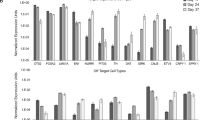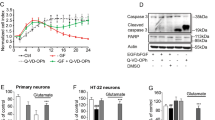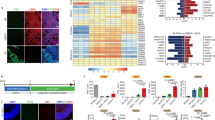Abstract
We investigated the hypothesis that neural stem cells (NSCs) possess an intrinsic capacity to “rescue” dysfunctional neurons in the brains of aged mice. The study focused on a neuronal cell type with stereotypical projections that is commonly compromised in the aged brain—the dopaminergic (DA) neuron. Unilateral implantation of murine NSCs into the midbrains of aged mice, in which the presence of stably impaired but nonapoptotic DA neurons was increased by treatment with 1-methyl-4-phenyl-1,2,3,6-tetrahydropyridine (MPTP), was associated with bilateral reconstitution of the mesostriatal system. Functional assays paralleled the spatiotemporal recovery of tyrosine hydroxylase (TH) and dopamine transporter (DAT) activity, which, in turn, mirrored the spatiotemporal distribution of donor-derived cells. Although spontaneous conversion of donor NSCs to TH+ cells contributed to nigral reconstitution in DA-depleted areas, the majority of DA neurons in the mesostriatal system were “rescued” host cells. Undifferentiated donor progenitors spontaneously expressing neuroprotective substances provided a plausible molecular basis for this finding. These observations suggest that host structures may benefit not only from NSC-derived replacement of lost neurons but also from the “chaperone” effect of some NSC-derived progeny.
This is a preview of subscription content, access via your institution
Access options
Subscribe to this journal
Receive 12 print issues and online access
$209.00 per year
only $17.42 per issue
Buy this article
- Purchase on Springer Link
- Instant access to full article PDF
Prices may be subject to local taxes which are calculated during checkout







Similar content being viewed by others
References
Aboody, K.S. et al. Neural stem cells display extensive tropism for pathology in adult brain: evidence from intracranial tumors. Proc. Natl. Acad. Sci. USA 97, 12846–12851 (2000).
Yandava, B.D., Billinghurst, L.L. & Snyder, E.Y. “Global” cell replacement is feasible via neural stem cell transplantation: evidence from the dysmyelinated shiverer mouse brain. Proc. Natl. Acad. Sci. USA 96, 7029–7034 (1999).
Bjorklund, A. & Lindvall, O. Cell replacement therapies for central nervous system disorders. Nat. Neurosci. 3, 537–544 (2000).
Snyder, E.Y., Yoon, C., Flax, J.D. & Macklis, J.D. Multipotent neural precursors can differentiate toward replacement of neurons undergoing targeted apoptotic degeneration in adult mouse neocortex. Proc. Natl. Acad. Sci. U.S.A. 94, 11663–11668 (1997).
Ourednik, V., Ourednik, J., Park, K.I. & Snyder, E.Y. Neural stem cells—a versatile tool for cell replacement and gene therapy in the central nervous system. Clin.Genet. 56, 267–278 (1999).
Snyder, E.Y., Taylor, R.M. & Wolfe, J.H. Neural progenitor cell engraftment corrects lysosomal storage throughout the MPS VII mouse brain. Nature 374, 367–370 (1995).
Grunblatt, E., Mandel, S., Maor, G. & Youdim, M.B.H. Gene expression analysis in N-methyl-4-phenyl-1,2,3,6-tetrahydropyridine mice model of Parkinson's disease using cDNA microarray: effect of R-apomorphine. J. Neurochem. 78, 1–12 (2001).
Sonsalla, P.K. & Heikkila, R.E. The influence of dose and dosing interval on MPTP-induced dopaminergic neurotoxicity in mice. Eur. J. Pharmacol. 129, 339–345 (1986).
Heikkila, R.E., Hess, A. & Duvoisin, R.C. Dopaminergic neurotoxicity of 1-methyl-4-phenyl-1,2,5,6-tetrahydropyridine in mice. Science 224, 1451–1453 (1984).
Gerlach, M. & Riederer, P. Animal models of Parkinson's disease: an empirical comparison with the phenomenology of the disease in man. J. Neural Transm. 103, 987–1041 (1996).
Przedborski, S. & Jackson-Lewis, V. Mechanisms of MPTP toxicity. Mov. Disord. 13 (Suppl. 1), 35–38 (1998).
Hamre, K., Tharp, R., Poon, K., Xiong, X. & Smeyne, R.J. Differential strain susceptibility following 1-methyl-4-phenyl-1,2,3,6-tetrahydropyridine (MPTP) administration acts in an autosomal dominant fashion: quantitative analysis in seven strains of Mus musculus. Brain Res. 828, 91–103 (1999).
Ourednik, J., Ourednik, W. & Van der Loos, H. Do foetal neural grafts induce repair by the injured juvenile neocortex? Neuroreport 5, 133–136 (1993).
Ourednik, J., Ourednik, W. & Mitchell, D.E. Remodeling of lesioned kitten visual cortex after xenotransplantation of fetal mouse neopallium. J. Comp. Neurol. 395, 91–111 (1998).
Desai, V.G., Feuers, R.J., Hart, R.W. & Ali, S.F. MPP(+)-induced neurotoxicity in mouse is age-dependent: evidenced by the selective inhibition of complexes of electron transport. Brain Res. 715, 1–8 (1996).
Mandavilli, B.S., Ali, S.F. & Van Houten, B. DNA damage in brain mitochondria caused by aging and MPTP treatment. Brain Res. 885, 45–52 (2000).
Heikkila, R.E., Sieber, B.A., Manzino, L. & Sonsalla, P.K. Some features of the nigrostriatal dopaminergic neurotoxin 1-methyl-4-phenyl-1,2,3,6-tetrahydropyridine (MPTP) in the mouse. Mol. Chem. Neuropathol. 10, 171–183 (1989).
Akerud, P., Canals, J.M., Snyder, E.Y. & Arenas, E. Neuroprotection through delivery of glial cell line–derived neurotrophic factor by neural stem cells in a mouse model of Parkinson's disease. J. Neurosci. 21, 8108–8118 (2001).
Wagner, J. et al. Induction of a midbrain dopaminergic phenotype in Nurr1-overexpressing neural stem cells by type 1 astrocytes. Nat. Biotechnol. 17, 653–659 (1999).
Rosario, C.M. et al. Differentiation of engrafted multipotent neural progenitors towards replacement of missing granule neurons in meander tail cerebellum may help determine the locus of mutant gene action. Development 124, 4213–4224 (1997).
Rubio, F.J. et al. BDNF gene transfer to the mammalian brain using CNS-derived neural precursors. Gene Ther. 6, 1851–1866 (1999).
Ourednik, V. et al. Segregation of human neural stem cells in the developing primate forebrain. Science 293, 1820–1824 (2001).
Ungerstedt, U. & Arbuthnott, G.W. Quantitative recording of rotational behavior in rats after 6-hydroxy-dopamine lesions of the nigrostriatal dopamine system. Brain Res. 24, 485–493 (1970).
Kuhar, M.J. Recent biochemical studies of the dopamine transporter—a CNS drug target. Life Sci. 62, 1573–1575 (1998).
Barr, M.L. & Bertram, E.G. A morphological distinction between neurones of the male and female, and the behaviour of the nucleolar satellite during accelerated nucleoprotein synthesis. Nature 163, 676–677 (1949).
Hong, B., Reeves, P., Panning, B., Swanson, M.S. & Yang, T.P. Identification of an autoimmune serum containing antibodies against the Barr body. Proc. Nat. Acad. Sci. USA 98, 8703–8708 (2001).
Magavi, S.S., Leavitt, B.R. & Macklis, J.D. Induction of neurogenesis in the neocortex of adult mice. Nature 405, 951–955 (2000).
Kordower, J.H. et al. Neurodegeneration prevented by lentiviral vector delivery of GDNF in primate models of Parkinson's disease. Science 290, 767–773 (2000).
Choi-Lundberg, D.L. et al. Dopaminergic neurons protected from degeneration by GDNF gene therapy. Science 275, 838–841 (1997).
Studer, L., Tabar, V. & McKay, R.D. Transplantation of expanded mesencephalic precursors leads to recovery in parkinsonian rats. Nat. Neurosci. 1, 290–295 (1998).
Storch, A. et al. Long-term proliferation and dopaminergic differentiation of human mesencephalic neural precursor cells. Exp. Neurol. 170, 317–325 (2001).
Bjorklund, L.M. et al. Embryonic stem cells develop into functional dopaminergic neurons after transplantation in a Parkinson rat model. Proc. Natl. Acad. Sci. USA 99, 2344–2349 (2002).
Martinez-Serrano, A. et al. CNS-derived neural progenitor cells for gene transfer of nerve growth factor to the adult rat brain: complete rescue of axotomized cholinergic neurons after transplantation into the septum. J. Neurosci 15, 5668–5680 (1995).
Bjorklund, A. et al. Towards a neuroprotective gene therapy for Parkinson's disease: use of adenovirus, AAV and lentivirus vectors for gene transfer of GDNF to the nigrostriatal system in the rat Parkinson model(1). Brain Res. 886, 82–98 (2000).
Lowenstein, P.R. & Castro, M.G. Genetic engineering within the adult brain: implications for molecular approaches to behavioral neuroscience. Physiol. Behav. 73, 833–839 (2001).
Ourednik, W. & Ourednik, J. Newly formed host cells in a grafted juvenile neocortex express neurone-specific marker proteins. Neuroreport 5, 1073–1076 (1994).
Hodges, H. et al. Conditionally immortal neuroepithelial stem cell grafts reverse age-associated memory impairments in rats. Neuroscience 101, 945–955 (2000).
Veizovic, T., Beech, J.S., Stroemer, R.P., Watson, W.P. & Hodges, H. Resolution of stroke deficits following contralateral grafts of conditionally immortal neuroepithelial stem cells. Stroke 32, 1012–1019 (2001).
Date, I., Notter, M.F., Felten, S.Y. & Felten, D.L. MPTP-treated young mice but not aging mice show partial recovery of the nigrostriatal dopaminergic system by stereotaxic injection of acidic fibroblast growth factor (aFGF). Brain Res. 526, 156–160 (1990).
Sidman, R.L., Angevine, J.B., Jr. & Taber-Pierce, E. Atlas of the Mouse Brain and Spinal Cord (Harvard University Press, Cambridge, MA, 1971).
Webster, W., Shimada, M. & Langman, J. Effect of fluorodeoxyuridine, colcemid, and bromodeoxyuridine on developing neocortex of the mouse. Am. J. Anat. 137, 67–85 (1973).
Cai, L., Hayes, N.L. & Nowakowski, R.S. Local homogeneity of cell cycle length in developing mouse cortex. J. Neurosci. 17, 2079–2087 (1997).
Acknowledgements
We thank Tom Yang and Wesley Brooks for their gift of the Barr body–specific immune serum and Mahesh Lachyankar in the Snyder laboratory for sharing unpublished data. We also thank Yvonne Bruderer and Markus Rimann for technical assistance, Kathrin Mannigel for maintenance of the animal colony, and Donald E. Mitchell, Olga Kukal, and Tom Allen for input. This work was supported in part by grants from the Swiss National Research Foundation to M.S., the Michael J. Fox/Parkinson Action Network to V.O., the International Institute for Research in Paraplegia, Zurich, to V.O. and E.Y.S., National Institutes of Neurological Diseases and Stroke, the A-T Children's Project, March of Dimes, Project ALS and the International Organization for Glutaric Acidemia to E.Y.S.
Author information
Authors and Affiliations
Corresponding authors
Ethics declarations
Competing interests
The authors declare no competing financial interests.
Supplementary information
Rights and permissions
About this article
Cite this article
Ourednik, J., Ourednik, V., Lynch, W. et al. Neural stem cells display an inherent mechanism for rescuing dysfunctional neurons. Nat Biotechnol 20, 1103–1110 (2002). https://doi.org/10.1038/nbt750
Received:
Accepted:
Published:
Issue Date:
DOI: https://doi.org/10.1038/nbt750
This article is cited by
-
Challenges in the clinical advancement of cell therapies for Parkinson’s disease
Nature Biomedical Engineering (2023)
-
Neuroprotection of Stem Cells Against Ischemic Brain Injury: From Bench to Clinic
Translational Stroke Research (2023)
-
Therapeutic potential of stem cells for treatment of neurodegenerative diseases
Biotechnology Letters (2020)
-
Neural stem cell-derived small extracellular vesicles attenuate apoptosis and neuroinflammation after traumatic spinal cord injury by activating autophagy
Cell Death & Disease (2019)
-
Neural stem cell therapy for subacute and chronic ischemic stroke
Stem Cell Research & Therapy (2018)



